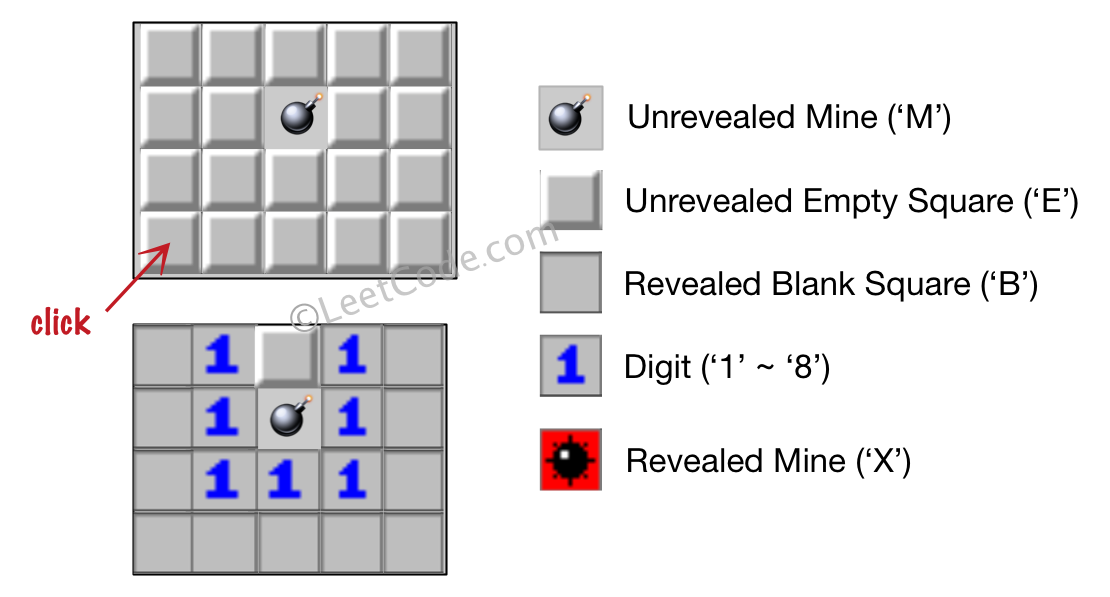Minesweeper
Let's play the minesweeper game (Wikipedia, online game)!
You are given an m x n char matrix board representing the game board where:
'M'represents an unrevealed mine,'E'represents an unrevealed empty square,'B'represents a revealed blank square that has no adjacent mines (i.e., above, below, left, right, and all 4 diagonals),- digit (
'1'to'8') represents how many mines are adjacent to this revealed square, and 'X'represents a revealed mine.
You are also given an integer array click where click = [clickr, clickc] represents the next click position among all the unrevealed squares ('M' or 'E').
Return the board after revealing this position according to the following rules:
- If a mine
'M'is revealed, then the game is over. You should change it to'X'. - If an empty square
'E'with no adjacent mines is revealed, then change it to a revealed blank'B'and all of its adjacent unrevealed squares should be revealed recursively. - If an empty square
'E'with at least one adjacent mine is revealed, then change it to a digit ('1'to'8') representing the number of adjacent mines. - Return the board when no more squares will be revealed.
Example 1:

Input: board = [["E","E","E","E","E"],["E","E","M","E","E"],["E","E","E","E","E"],["E","E","E","E","E"]], click = [3,0]
Output: [["B","1","E","1","B"],["B","1","M","1","B"],["B","1","1","1","B"],["B","B","B","B","B"]]
Example 2:

Input: board = [["B","1","E","1","B"],["B","1","M","1","B"],["B","1","1","1","B"],["B","B","B","B","B"]], click = [1,2]
Output: [["B","1","E","1","B"],["B","1","X","1","B"],["B","1","1","1","B"],["B","B","B","B","B"]]
Constraints:
m == board.lengthn == board[i].length1 <= m, n <= 50board[i][j]is either'M','E','B', or a digit from'1'to'8'.click.length == 20 <= clickr < m0 <= clickc < nboard[clickr][clickc]is either'M'or'E'.
Solution
There are a few things we need to keep in mind when implementing the problem:
- blank squares (
'B') and digit squares ('1'-'8') should be treated differently - a blank square's neighbours need to be revealed recursively
- only recursively reveal empty squares ('E')
We are given the click coordinate to update the board. If click is a mine ('M'), then we change it to 'X'.
If it's an empty square, then the update function updates the empty square recursively.
Implementation
1def updateBoard(board: List[List[str]], click: List[int]) -> List[List[str]]:
2 if board == []: return []
3 row = len(board)
4 col = len(board[0])
5
6 def isbomb(i, j):
7 if i < 0 or j < 0 or i >= row or j >= col:
8 return False
9 elif board[i][j] == 'M' or board[i][j] == 'X':
10 return True
11 else: return False
12
13 def update(r, c):
14 if r < 0 or c < 0 or r >= row or c >= col: return
15 if board[r][c] == 'E': # empty square
16 bombs = 0 # number of neighbouring bombs
17 for i in range(r-1, r+2):
18 for j in range(c-1, c+2):
19 if isbomb(i, j): bombs += 1
20 if bombs: # update cell with number of bombs
21 board[r][c] = chr(48 + bombs)
22 else: # blank cell (0 bombs)
23 board[r][c] = 'B'
24 for i in range(r-1, r+2): # update neighbours
25 for j in range(c-1, c+2):
26 update(i, j)
27 # else already revealed, do nothing
28
29 r, c = click[0], click[1]
30 if board[r][c] == 'M': # bomb
31 board[r][c] = 'X'
32 else: # empty square, or revealed square
33 update(r, c)
34 return board
Which of the following is a good use case for backtracking?
What's the output of running the following function using the following tree as input?

1def serialize(root):
2 res = []
3 def dfs(root):
4 if not root:
5 res.append('x')
6 return
7 res.append(root.val)
8 dfs(root.left)
9 dfs(root.right)
10 dfs(root)
11 return ' '.join(res)
121import java.util.StringJoiner;
2
3public static String serialize(Node root) {
4 StringJoiner res = new StringJoiner(" ");
5 serializeDFS(root, res);
6 return res.toString();
7}
8
9private static void serializeDFS(Node root, StringJoiner result) {
10 if (root == null) {
11 result.add("x");
12 return;
13 }
14 result.add(Integer.toString(root.val));
15 serializeDFS(root.left, result);
16 serializeDFS(root.right, result);
17}
181function serialize(root) {
2 let res = [];
3 serialize_dfs(root, res);
4 return res.join(" ");
5}
6
7function serialize_dfs(root, res) {
8 if (!root) {
9 res.push("x");
10 return;
11 }
12 res.push(root.val);
13 serialize_dfs(root.left, res);
14 serialize_dfs(root.right, res);
15}
16Solution Implementation
Which of the following problems can be solved with backtracking (select multiple)
Consider the classic dynamic programming of longest increasing subsequence:
Find the length of the longest subsequence of a given sequence such that all elements of the subsequence are sorted in increasing order.
For example, the length of LIS for [50, 3, 10, 7, 40, 80] is 4 and LIS is
[3, 7, 40, 80].
What is the recurrence relation?
Recommended Readings
Top Patterns to Conquer the Technical Coding Interview Should the written word bore you fear not A delightful video alternative awaits iframe width 560 height 315 src https www youtube com embed LW8Io6IPYHw title YouTube video player frameborder 0 allow accelerometer autoplay clipboard write encrypted media gyroscope picture in picture
Recursion Recursion is one of the most important concepts in computer science Simply speaking recursion is the process of a function calling itself Using a real life analogy imagine a scenario where you invite your friends to lunch https algomonster s3 us east 2 amazonaws com recursion jpg You first
Runtime Overview When learning about algorithms and data structures you'll frequently encounter the term time complexity This concept is fundamental in computer science and offers insights into how long an algorithm takes to complete given a certain input size What is Time Complexity Time complexity represents the amount of time
Got a question? Ask the Teaching Assistant anything you don't understand.
Still not clear? Ask in the Forum, Discord or Submit the part you don't understand to our editors.